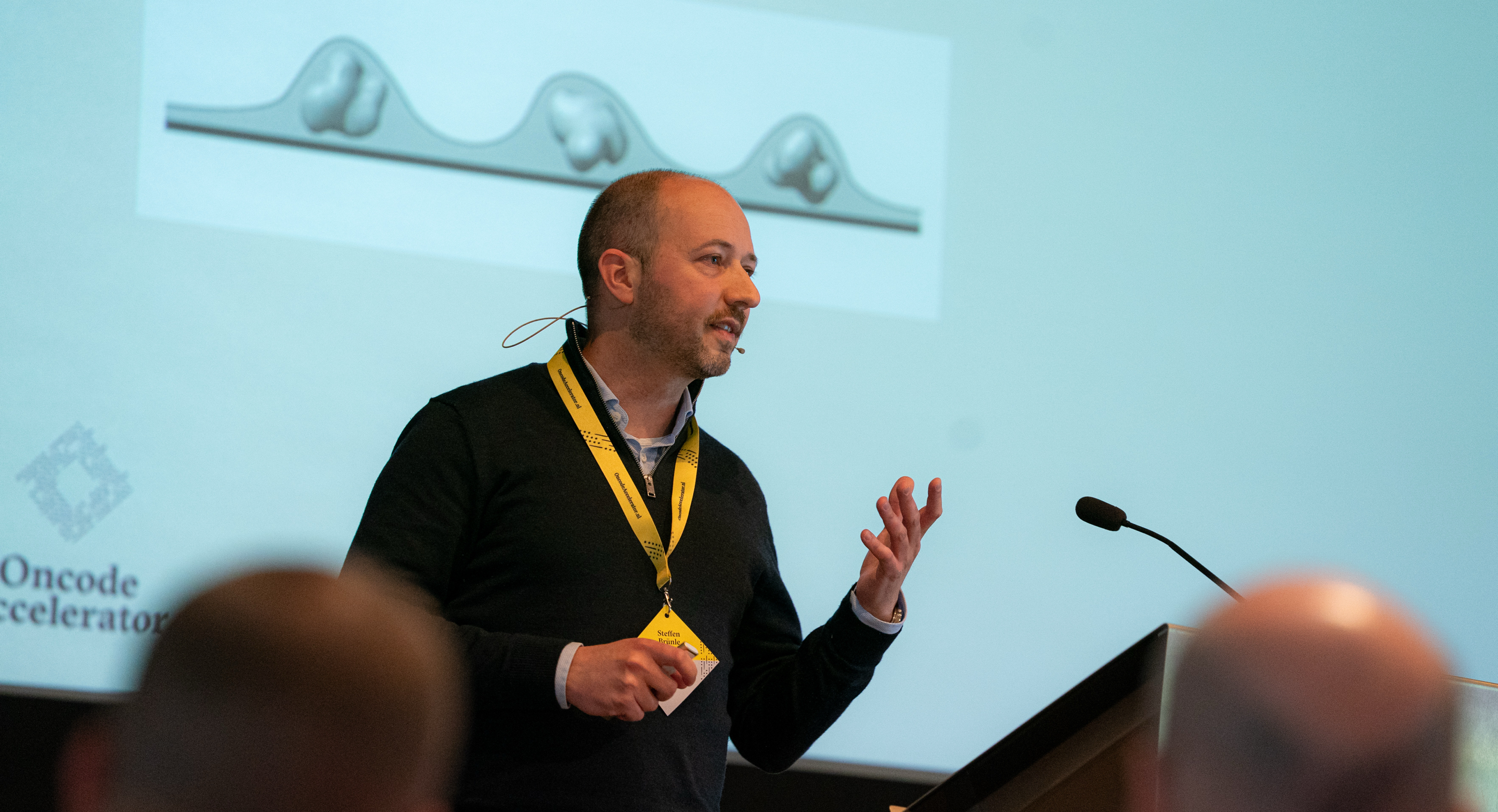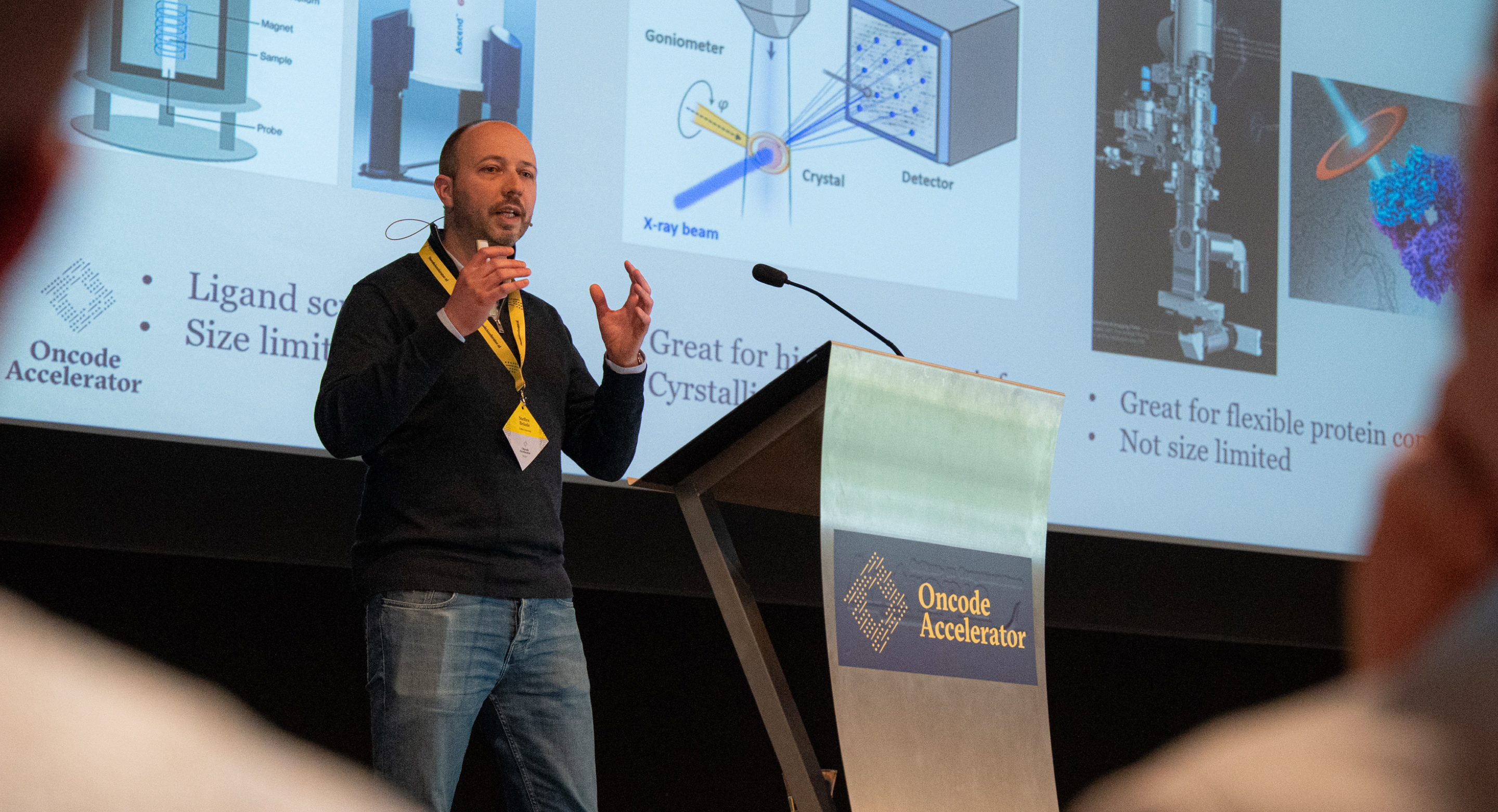Our Innovative Infrastructure
02

Accelerating Structure-Based Drug Design: How Top Cryo-EM Technology Can Fast-Track Cancer Research
To accelerate cancer research, the Oncode Accelerator program recently invested in a state-of-the-art Glacios cryo-EM microscope. Dr. Steffen Brünle, Assistant Professor at Leiden University, explains how this technology is helping scientists to fast-track their cancer research.
Structure matters, in daily life and in biology. For instance, think of a water bottle. You understand how to use it just by looking at it — where to pour water, how to close it, and how it holds liquid. This simple idea also applies to biology.
“If you understand the structure of a molecule, you can start to understand the function,” explains Steffen Brünle, Assistant Professor at Leiden University and member of the Oncode Accelerator Small Molecules Workstream. “So, if you know how a protein looks in 3D, you can begin to understand how it works. It’s like knowing if a water bottle has a screw cap or a pop-top — once you know how it looks, you can understand how to interact with it.”
If you understand the structure of a molecule, you can start to understand the function.
Dr. Steffen Brünle, Assistant Professor at Leiden University
In recent years, cryo-electron microscopy (cryo-EM) — one of several techniques used to study the structure of molecules — has become a powerful tool for drug discovery and development. It helps researchers to understand the shapes of molecules in detail, which is crucial for understanding how molecules work and designing drugs to interact with those molecules in specific ways. Cryo-EM has revolutionized this area of research, a field known as structural biology, by making it easier for scientists to get clear, high-resolution images of tiny molecules much faster than before. The importance of this method was recognized with the Nobel Prize in Chemistry in 2017. The winning scientists developed a way to freeze molecules in place so they could be imaged in striking detail — down to the level of individual atoms.

Where Structure Meets Strategy in Drug Discovery and Development
Steffen Brünle became fascinated with structural biology early in his career, and it brought him from Germany to Switzerland, and eventually to the Netherlands where he now leads a research group at Leiden University. His research group is driven by an overarching goal: “to better understand protein interactions, and how we could design drugs to influence those interactions,” Steffen explains.
In particular, Steffen’s research group studies G protein-coupled receptors (GPCRs), a family of proteins that plays a crucial role in how cells respond to different signals. GPCRs are also important targets in drug discovery – many drugs work by targeting these receptors. His group focuses on uncovering how different molecules interact with GPCRs in different ways, to trigger different outcomes.
“Depending on where a molecule binds to the receptor, it can cause completely different responses in the cell,” says Steffen. “If we can understand that process better, we can design drugs that are more precise — and thereby limit side effects for patients.”
Using Top Tech to Fast-Track Research
The Glacios microscope recently purchased through Oncode Accelerator can support scientists in achieving this goal of designing precision medicines faster. Steffen explains: “This microscope is very well developed. It allows us to very rapidly gain insights into our samples at a fraction of the cost compared to other microscopes, and in only a few hours.”
In the past, cryo-EM scientists used a time-consuming, three-step process to study the structure of molecules. This process also involved three different microscopes. Now, the Glacios – which makes use of the latest innovations in electron microscopy – has simplified that long process into a single, streamlined step. “The Glacios is a highly capable instrument that allows us to accelerate our science considerably,” comments Steffen.
The Glacios microscope's efficiency and cost-effectiveness make it a valuable investment within the Oncode Accelerator ecosystem – in line with our mission to collaboratively optimize and accelerate the development of new cancer therapies for the benefit of patients of all ages.
Being based in Leiden and within the Oncode Accelerator program is ideal for my research. This ecosystem brings together experts in medicine, chemistry, and other drug discovery-related disciplines, which creates a great research environment.
Dr. Steffen Brünle, Assistant Professor at Leiden University
The Power of Collaborative Science
Alongside top tech, the right kind of collaboration can also accelerate drug discovery. Embedding cryo-EM expertise and technologies into Oncode Accelerator’s research ecosystem can boost the ability of scientists to rapidly design and optimize small molecule cancer therapeutics.
Steffen explains: “Being based in Leiden and within the Oncode Accelerator program is ideal for my research. This ecosystem brings together experts in medicine, chemistry, and other drug discovery-related disciplines, which creates a great research environment.”
This kind of collaboration, which blends complementary expertise, can help scientists to progress much faster. For instance, teams working on developing cancer drugs can use cryo-EM to see exactly how different compounds could interact with target proteins – and then once they have that information, efficiently fine-tune those compounds to make them work better.
“There are a lot of collaborative projects going on,” says Brünle. “Many people are now developing small molecules, for instance as potential cancer therapies, and there is a lot of interest in using cryo-EM to see how those molecules interact with a protein of interest. Once you have that information, then you can use a structure-based drug discovery approach to optimize your drug candidate.”
Steffen Brünle's work underlines how combining cutting-edge technology with strong collaboration can accelerate scientific discovery and development. By using top tech like the Glacios cryo-EM microscope, researchers can accelerate towards developing more effective, targeted treatments that could eventually benefit cancer patients.
About
Dr. Patrick Kemmeren
Research group leader at the Princess Máxima Center and team lead in the Oncode Accelerator Well-defined patient cohorts workstream.